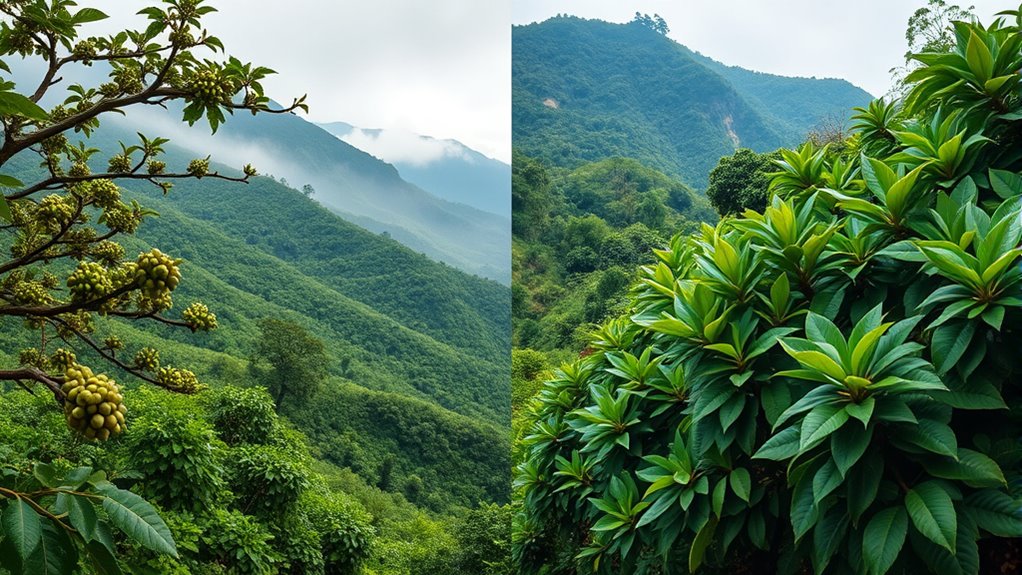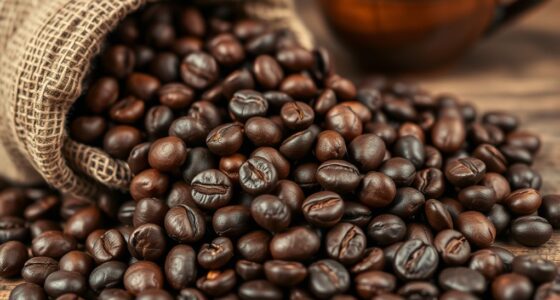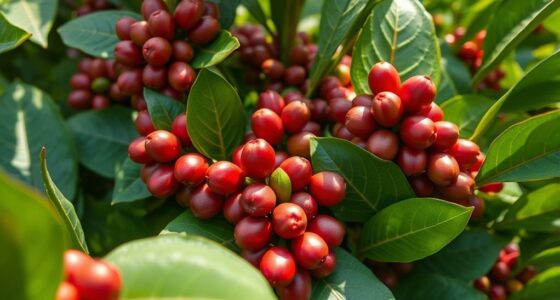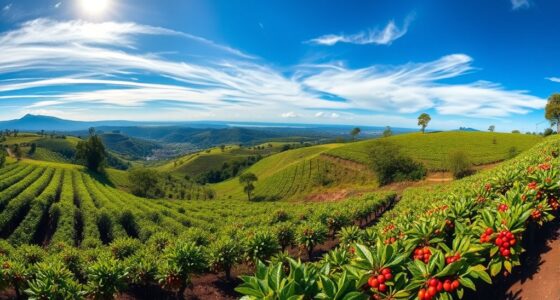Arabica beans thrive in high-altitude, cooler regions like Ethiopia, Colombia, and Central America, offering a smooth, nuanced flavor profile loved by coffee enthusiasts. In contrast, Robusta grows in warmer, lower-altitude areas such as Vietnam, Brazil, and parts of Africa, producing a stronger, more bitter taste with earthy or nutty notes. These regional differences shape their unique flavors, and exploring their origins helps you understand the distinct qualities of each. If you want to know more, keep exploring how these regions influence flavor profiles.
Key Takeaways
- Arabica thrives in high-altitude, cooler regions like Ethiopia, Colombia, and Central America, producing complex flavors.
- Robusta grows well in lower-altitude, warmer climates such as Vietnam, Brazil, and parts of Africa, with a stronger, earthy taste.
- Arabica’s delicate cultivation requires shade and precise watering, often in volcanic soils, impacting regional quality and flavor.
- Robusta’s hardy nature allows cultivation in diverse, less restrictive regions, resulting in a bolder, more bitter flavor profile.
- Flavor differences: Arabica offers smooth, nuanced taste, while Robusta has a stronger, bitter, earthy flavor with higher caffeine content.

Are you curious about what sets Arabica and Robusta apart? The differences go beyond just flavor—they extend into how they’re cultivated, where they’re grown, and their caffeine content. Knowing these distinctions can help you better understand your favorite coffee and choose what suits your taste and needs best.
Arabica coffee beans are generally considered higher quality and are more widely sought after, especially in specialty coffee circles. They thrive in high-altitude regions with cooler temperatures, such as Ethiopia, Colombia, and Central America. These areas provide the perfect conditions for Arabica plants to flourish, thanks to well-drained volcanic soil and consistent rainfall. Cultivation practices for Arabica are more delicate; the plants need careful attention, shade, and precise watering. Because of these demanding conditions, Arabica cultivation often results in a lower yield compared to Robusta, but the beans tend to have a more complex flavor profile. When it comes to caffeine content, Arabica beans usually contain about 1.2% caffeine, making them milder and less bitter than Robusta. This lower caffeine level contributes to their smooth, nuanced taste, which many coffee lovers prefer for drinking black or with minimal additives.
Robusta, on the other hand, grows well in lower-altitude areas with warmer climates, such as Vietnam, Brazil, and parts of Africa. These regions provide the conditions needed for Robusta plants to thrive, which are generally more resilient and easier to cultivate. Robusta plants are hardier and resistant to pests and diseases, allowing farmers to produce larger quantities with less effort. Cultivation practices are less restrictive, making Robusta more affordable and accessible. The beans tend to have a stronger, more bitter flavor with earthy, woody, or nutty notes, which appeals to those who enjoy a bolder coffee. Caffeine content in Robusta beans is higher—around 2.2%—which makes the coffee more stimulating. This increased caffeine level also contributes to the characteristic bitterness and full-bodied flavor of Robusta coffee.
Frequently Asked Questions
How Do Climate Changes Affect Arabica and Robusta Growth?
Climate changes impact coffee growth by challenging crop resilience and demanding climate adaptation strategies. You might notice shifts in suitable growing areas, increased risks of droughts or floods, and stress on plants. To maintain productivity, farmers need to develop resilient crops and adopt new practices. These efforts help guarantee coffee plants can withstand changing conditions, securing future supplies and flavors. Your awareness of climate impacts highlights the importance of sustainable, adaptive farming methods.
Are There Health Benefits Unique to Each Coffee Type?
You’re curious about the health benefits of each coffee type. Arabica offers unique advantages like higher antioxidant levels, which may support heart health. Robusta contains more caffeine and chlorogenic acids, providing extra energy and potential weight loss benefits. Both types contribute antioxidants and may reduce disease risks, but each has its own health perks. Choosing between them depends on your health goals and flavor preferences, so explore their unique benefits to see what suits you best.
Which Region Produces the Highest-Quality Arabica Beans?
You wonder which region produces the highest-quality Arabica beans. When considering Arabica quality, regional cultivation plays a vital role, with countries like Colombia, Ethiopia, and Costa Rica renowned for their premium beans. These regions have ideal climates, high altitudes, and rich soils that enhance flavor complexity. Your best bet for top Arabica quality is to explore beans from these areas, where regional cultivation truly elevates the coffee’s overall excellence.
How Does Altitude Influence Flavor Profiles?
Imagine the gentle touch of altitude shaping your coffee experience. You’ll notice that higher elevations bring out a brighter acidity and more nuanced flavor, elevating your sip. As elevation increases, the coffee’s complexity deepens, offering a vibrant taste that dances on your palate. Altitude influences acidity and overall flavor, making each cup a unique journey. Embrace the elevation’s role in crafting the rich tapestry of your coffee’s character.
What Sustainable Practices Are Used in Arabica and Robusta Cultivation?
You can adopt sustainable practices like shade-grown methods and organic farming to safeguard coffee crops. Shade-grown practices preserve biodiversity, reduce the need for chemical inputs, and maintain soil health. Organic farming avoids synthetic pesticides and fertilizers, promoting eco-friendly cultivation. By implementing these practices, you support environmental sustainability and guarantee healthier coffee production, whether for Arabica or Robusta, benefiting both farmers and ecosystems in the long run.
Conclusion
Imagine choosing between two singers: Arabica’s smooth, complex tones and Robusta’s bold, punchy notes. You might prefer Arabica for its nuanced flavor, much like savoring a fine wine, while Robusta’s robust punch hits harder, like a shot of espresso. Both have their place, just like different regions produce distinct flavors. Ultimately, your choice depends on what kind of experience you crave—delicate harmony or bold resilience. The world of coffee is as rich as its stories.









